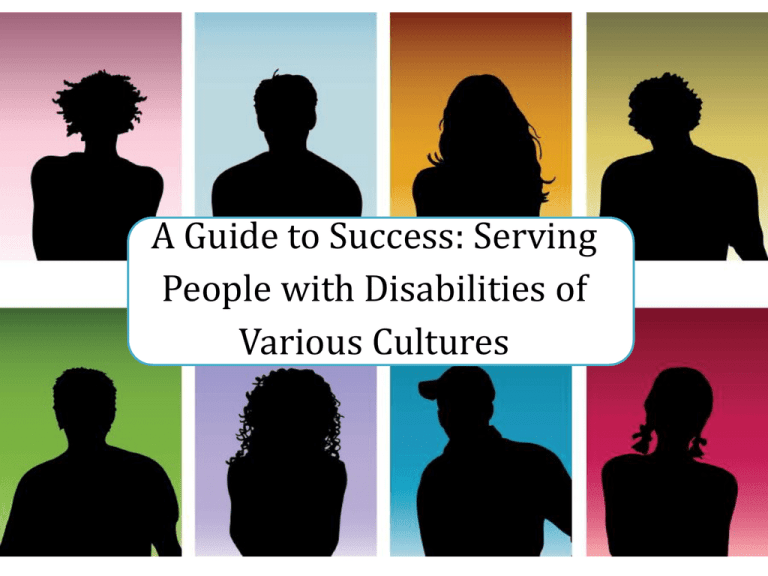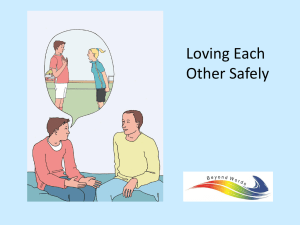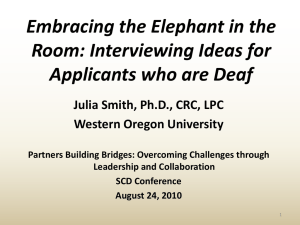
A Guide to Success: Serving
People with Disabilities of
Various Cultures
Learning Objectives
-Discuss Assumptions, Stereotypes and Generalizations
-Define Culture and Cultural Competency
-Learn about Disability and Various Types of Disabilities
-Understanding Service Animals and Other
Accommodations
-Examining the Effects of Violence and Trauma on
Disability
-Response to Victims with Disabilities
-Any other topics?
M
Generalizations vs. Stereotypes
Generalizations are statements or beliefs about a cultural group
based upon factual evidence. While generalizations apply to the majority
of people within a cultural group they may not be true of every single
person within that group. Generally speaking, the majority of Latin
Americans are Catholic, but not every Latin American is Catholic.
Stereotypes are oversimplifications of a group’s characteristics.
Stereotypes can be based on some factual elements but are not generally
applicable to an entire cultural group. It would be accurate to say that
there are many African Americans who are rappers or who play
professional basketball. Saying that all African Americans play basketball
and listen to rap would be stereotyping.
JC
Where are you from?
Have you been asked the question
“Where are you from? I have…many
times. Let us watch the following
video:
http://www.youtube.com/watch?v=crAv5ttax2I
JC
What is Culture?
Culture is an integrated pattern of human behavior includes
but is not limited to –
thought, communication, languages, beliefs, values, practices,
customs, courtesies, rituals, manners of interacting, roles,
relationships, and expected behaviors of a racial, ethnic, religious,
social or political group; the ability to transmit the above to
succeeding generations; dynamic, ongoing and evolving.
Developed by the National Center for Cultural Competence, 2001
JC
Cultural
Competency
Cultural competency is defined as “a set of cultural
behaviors and attitudes integrated into the practice
methods of a system, agency, or its professionals, that
enables them to work effectively in cross cultural
situations.”
JC
How do I achieve
Cultural Competency?
Cultural competency is achieved by translating and
integrating knowledge about individuals and groups of people
into specific practices and policies applied in appropriate
cultural settings.
JC
Iceberg Concept
JC
Cultural Sensitivity/Safety
Cultural Sensitivity is being aware of cultural
differences without assigning value (i.e. better or worse, right or wrong)
to those differences..
Safety : Being in compliance with rules, regulations, policies and
laws. This includes showing respect toward people regardless of race,
national origin, religion, disability, sex/gender (including pregnancy),
color, veteran status, age, sexual orientation, gender identity/expression,
or genetic information. USU Policy 305.1
JC
Ethnocentrism
“What you see in yourself, you see in the world.”- Afghan Proverb
It is the universal tendency of human beings to feel that their ways of
thinking, acting, and believing are the only right, proper, and natural
ways of interrupting life. This mindset is called Ethnocentrism
(ethno=nation; centrism=centric).
An ethnocentric person is akin to
someone looking in a mirror in that they
only see a reflection of themselves. A
culturally sensitive person understands
that everyone has a different cultural
background and may not interpret the
world in the same manner as they
themselves would.
(Lynch & Hanson 1992 Developing Cross Cultural Competence)
JC
Effective
Communication
Communication provides an opportunity for persons of
different cultures to learn from each other. It is important
to build skills that enhance communication. This means
not only using the language and dialect of the people you
are serving, it means using communication vehicles that
are proven to have significant value and use by your
target audience.
JC
Stages of Intercultural
Sensitivity
1.
2.
3.
4.
5.
Denial: does not recognize cultural differences
Defense: Recognizes some differences, but sees them as negative
Minimization: unaware of projecting of own cultural values; sees own
values as superior
Acceptance: shifts perspectives to understand that the same
“ordinary” behavior can have different meaning in different cultures
Adaptation: Can evaluate other’s behavior from their frame of
reference and can adapt behavior to fit the norms of a different
culture
JC
People with Disabilities
M
Largest and most diverse group
People with disabilities constitute our largest and most
diverse minority group (one in five Americans), encompassing
all ages, genders, religions, ethnicities, and socioeconomic
levels. It is also the only group that any person can join at any
time, and will if they live long enough.
Disability is a natural part of the human experience. People
have the right to live independently, control their life, and
fully participate in their community.
Disability is often a result of social, architectural and
environmental barriers. Barriers exist within society, not
within the person.
Children and adults with disabilities are unique individuals
with unlimited potential, like everyone else (Snow, 2008). M
General Communication Recommendations for
People with Disabilities
Rethink your attitude about people with
disabilities. Don’t make assumptions.
Treat them the same as everyone else. Don’t
treat them like a child or say, “honey” or
“sweetie.”
Always ask before helping. Wait and listen.
Ask how they prefer to communicate.
Treat individuals with disabilities with
respect, dignity and courtesy.
M
Hidden Disabilities may include:
Traumatic Brain Injuries
Mental Illness
Hard of Hearing
Learning Disabilities
Mild Multiple Sclerosis
Chemical Sensitivities
Heart Disease
Arthritis
Chronic Fatigue
Can you think of any others?
M
Misperceptions
Be aware of misperceptions and common
assumptions:
People with cerebral palsy may appear to be
under the influence of drugs or alcohol.
People with traumatic brain injuries may act
aggressive or irresponsible.
Individuals with mental illness may have trouble
listening and staying on task.
People who are hard of hearing may not respond.
N
Individual Differences
• In the next section, several disabilities will be
discussed along with communication
suggestions.
• This information is very general and is simply
intended to provide a broad overview.
• Please keep in mind that each individual is
unique. Symptoms of disability may also vary
from day to day for an individual.
N
Communicating and Interacting with People
with Developmental Disabilities
Diverse group of severe chronic conditions
that affect major life activities such as
language, mobility, learning, self-care, selfdirection and independent living.
Begins anytime during development from
birth to 22 years of age and usually lasts
throughout a person’s lifetime.
Includes autism, cerebral palsy, Down
syndrome, and intellectual disabilities.
N
Cognitive/Intellectual Disabilities
Limited ability to think, remember, interpret
social cues, and understand numbers and
symbols.
Possible communication difficulties:
Limited vocabulary
Short attention span
Slower information processing
Difficulty understanding questions
Memory gaps
N
Communication with People who have
Intellectual Disabilities
Talk to the person to get a sense of their abilities.
Help the person feel safe, be patient and establish trust.
Use short words and sentences.
Provide more time to respond with breaks. If person
doesn’t respond, calmly rephrase.
Ask them to repeat what you told them.
Let them know it’s okay to say, “I don’t understand.”
Break complex information into smaller parts and give
directions one at a time. Describe things clearly.
Offer help with instructions or completing forms.
They may be easily distracted. Repeat if needed. (U.S. DOJ,
2002)
N
Muscular/Neurological
A broad range of disabilities affect movement.
Cerebral Palsy is caused by damage to the brain with
limited control of motor functions. May have speech
difficulties, unsteady gait, slow reactions. Does not affect
intelligence but may co-exist with intellectual disability.
Multiple Sclerosis is a chronic disease which attacks the
central nervous system (brain, spinal cord and optic
nerves). Severity and symptoms vary, but often tire
easily, with tremors, pain, and coordination difficulties.
Vision, speech, hearing and cognitive function may be
affected.
N
Communicating with people who have
difficulty speaking
People with Cerebral Palsy, Downs Syndrome and
some other disabilities may be difficult to
understand.
Provide extra time and let people talk at their
own pace. Give them your complete attention.
Ask them to repeat if you don’t understand.
Never pretend to understand. Ask yes/no
questions if necessary.
Repeat or rephrase what the person is saying to
clarify that you understand.
Be patient, flexible and encouraging.
N
Communicating with people who use
wheelchairs or scooters
Offer to shake hands, even if the person appears to
have little strength or movement.
When talking to a person in a wheelchair or scooter
at any length, sit or kneel so that they don’t have to
strain their neck.
Talk directly to the person.
Don’t lean on, push, pat or touch a person’s scooter.
If a person is unable to hold a pen, ask how you can
help. For instance, “Would you like help filling out
this form?”
N
Traumatic Brain Injury
(TBI)
• A brain injury may result in changes in behavior,
thinking, personality, and appearance.
– Lacking in impulse control
– High degree of frustration and anger
– Poor executive function (say what they think)
– Inappropriate decisions
– Difficulty solving problems
– Lack of self-monitoring
– Easily fatigued
M
TBI Communication Tips
Simplify as much as possible.
Get the person’s attention, redirect if needed.
Ask short, simple questions in a calm way.
Wait for a response. Rephrase if needed.
Highlight important information.
Watch for sudden outbursts or change in
behavior. Expect the unexpected.
M
Autism Spectrum Disorder
• Complex brain disorder that primarily affects
communication, social skills and behaviors.
• Affects every person differently and to varying
degrees – on a spectrum.
• May exhibit repetitive language (echo), hand
flapping, twirling objects or rocking.
• Many have little or no eye contact.
• May have fixation on parts of objects.
H
Autism Spectrum Disorder
•
•
•
•
•
•
•
Try not to touch the person, if possible.
Do not stop the person from rocking or flapping.
Visual information may be better, if possible.
Ensure questions are direct and clear.
Give the person more time to respond.
Turn down lights and sounds, if possible.
Words are taken very literally. Don’t use
metaphors or sarcasm, like you’re pulling my leg.
H
Communication with Persons
who are Blind
Visual impairments range from mild to severe.
Identify yourself and anyone with you. Don’t
just start talking. Let the person know when
you leave.
Speak in a normal tone of voice.
Always ask the person what is the best way to
provide assistance.
Describe , (e.g. there is a table on your right).
S
Guiding a Person who is Blind
• If you need to guide the person, offer your elbow,
and let the person hold on to you and identify
obstacles, such as steps, low hanging objects.
• If you offer a seat, place the person’s hand
on the back or arm of the chair or pat the chair.
• Don’t grab, distract or pet a guide dog.
• Don’t separate the dog from the person.
• Provide information in electronic or
other alternative format.
S
Service Animals
• Any dog trained to perform specific tasks for persons with
disabilities, such as guiding a person who is blind, alerting a
person who is Deaf, helping a person with cognitive
disabilities navigate, picking up objects or the phone,
alerting for seizures, providing help with balance or
interrupting impulsive behaviors.
• You may ask two questions:
– Is this a service animal?
– What task has this animal been trained to perform?
• You may NOT ask:
– About the person’s disability
– For a demonstration of tasks
– Documentation of training, certification, license
• It is the responsibility of the handler to control, care for,
feed, and supervise the service animal.
S
Reasonable Accommodations
• Federal law requires reasonable modifications
to policies, practices and procedures for
persons with disabilities, unless it
fundamentally alters the service, program, or
activity the agency provides.
• Ensure that communication with people with
disabilities/Deaf individuals is as effective.
S
Deaf and Hard of Hearing
• Demographics
• Utahans with Hearing Loss: 226,979* (and
counting)
• Seniors (55+) 99,952
• Culturally Deaf: 204
• Mild to Severe Hearing Loss: 224,664
• Profound Hearing Loss: 2,111
MM
Who Are They?
American Sign Language (ASL) users, sometimes
known as culturally Deaf.
Bilingual users of ASL and English. In this context,
ASL may include a wide variety of manual
communication forms.
Oralists and hard of hearing individuals who use
their voices and rely on speech reading or
residual hearing.
Deafened individuals who become deaf after
hearing normally, usually after learning to speak.
Elderly persons who lose their hearing, sometimes
called Late-deafened adults.
MM
Who are They cont.
Deaf people who know neither ASL nor written
English. These people may speak but not
write; they may be new Americans, or
persons, who use home signs, gesture or
mime.
Deaf-blind individuals who use Braille and/or
tactile signing to communicate.
Persons with speech disabilities may include
people with single or multiple disabilities.
MM
Deaf Culture
English as a Second Language—
For those who become profoundly deaf as
infants, learning to use English is like trying to
build a house without plans or carpentry
experience.
-- Lou Ann Walker, Author on Deafness
MM
Communication Strategies
1)
2)
3)
4)
5)
Maintain Eye Contact
Use paper and pen/pencil for clarification
Admit when you don’t understand
Use appropriate ways of getting attention
Learn to use Instant Messaging, text, Fax
Machine, and/or Relay Service
6) Use the term “Deaf” and/or “Hard of Hearing”
7) Don’t cover your face (visual input is necessary)
MM
Communication Strategies cont.
8) Don’t shout or whisper in their ear
9) Don’t assume all Deaf and Hard of Hearing
people are good lip readers
10) Don’t assume someone with a hearing aid can
understand speech
11) Don’t allow others to interrupt
12) Don’t correct a Deaf person’s English skill
13) Treat Deaf and Hard of Hearing people as
individuals
MM
Technology for D/HH
• Assistive Listening Devices (FM/Infrared/
loop systems)
• Alert Devices (Flash, Vibrate, Pagers)
• Communication Devices (Video Phones,
Smartphone apps, TTY)
• Computers/Laptops (Several available
software)
• Interpreters
MM
Person First Language
People with disabilities are people first. They are not all
alike. The only thing they have in common is prejudice
and misunderstanding. They are all unique (Snow, 2008).
Portrays people with disabilities as independent,
productive, valued, and respected members of society.
Person first language puts the person first, with a
description of their disability, if necessary.
Child with a disability, woman with M.S., person using a
wheelchair.
It describes what a person has, not who a person is.
H
Domestic Violence can cause
temporary or permanent disability
• Domestic Violence is the leading cause of injury
to women between the ages of 15 to 44 in the
United States.
• Disabilities resulting from abuse can range
from actual physical disabilities to more hidden
ones, like head injuries, spinal cord injuries,
and Post Traumatic Stress Disorder (PTSD).
• Most sexual assaults go unreported. Three
studies found 40%, 75% and 97% were
unreported for people with disabilities. (Criminal
Justice and Behavior, Vol. 28, No. 6, 2001)
H/D
People with Disabilities and
Domestic/Sexual Violence
• As many as 83% of women with disabilities are
survivors of domestic violence or sexual assault
according (National Crime Victimization Survey).
• Women with disabilities had a 40 % greater risk
of violence and are three times more likely to be
sexually assaulted than women without
disabilities. Brownridge, Douglas: ”Partner Violence Against Women with Disabilities”
• Persons with cognitive disabilities had the highest
risk of violent victimization.- Bureau of Justice Statistics. H/D
The Masks of Trauma and Disability
• Common reactions to trauma can look like a
disability.
• Trauma can change the way a disability
manifests itself.
D
The Anger Umbrella
• Anger is never a primary emotion, there is
always something underneath…
Fear
Shame
Guilt
Frustration
Isolation
Embarrassment
Loneliness
Helplessness
D
Looks like, but is it?
• Anger, Frustration = Aggression
• Shame, Fear, Guilt, Embarrassment = Avoidance
of eye contact
• Fear + physical trauma = touch phobia
• Fear, Isolation, Loneliness = paranoia
• Sometimes trauma can lead to disability…
D
What could these symptoms denote?
•
•
•
•
•
•
•
•
•
Fearful
Paranoia
Memory Loss
Easily Frustrated
Quick to Anger
Socially Withdrawn
Confusion
Hypervigilance
Dissociation
D
Post-Traumatic Stress Disorder
• Develops after a person is exposed to one or
more traumatic events, such as sexual assault,
warfare, serious injury, or threats of imminent
death that result in feelings of intense fear,
horror, and powerlessness.
• Not everyone that experiences trauma
develops PTSD.
• Symptoms must last for at least one month for
diagnosis and can last for a lifetime.
D
Advocacy Tips for PTSD
•
•
•
•
Allow extra time to understand materials.
Patience.
Redirect attention when needed.
All entrances and exits within eyesight of
client.
• Announcing and explaining your
actions/movements beforehand.
• Asking before touching, directing, etc.
D
Trauma and Disability
• If a disability already exists, trauma can
worsen it.
• Behavioral changes can occur overtime.
• Regardless of communication issues, a person
with a disability can tell you when something
is wrong. The signs will be there, learn to
recognize them.
D
Culture is no excuse for abuse
• Cultures differ in their values and beliefs
about gender roles and intimate relationships,
but is no excuse for physical battering or
psychological abuse, which do not correspond
with any culture’s ideals for intimate
relationships.
H
Response to Victims
• Regard the person as an equal. Reject the
common view that the person with a disability
needs to be fixed or pitied.
• Respect the person’s struggle as well as
her/his strength as a survivor.
• Assume all people with disabilities are
capable. Help each person identify her/his
strengths and capabilities. Build on them.
• Believe and Empower them!
H
Just Ask
• If you make a linguistic or behavioral mistake,
simply apologize and maintain your
willingness to communicate.
• Do not talk down to a person.
• Do not ask personal questions about person’s
disability.
• “If you are unsure of how to act or what to
say, just ask!”
H
Don’t be discouraged or give up…
• "I've missed more than 9000 shots in my
career. I've lost almost 300 games. 26 times,
I've been trusted to take the game winning
shot and missed. I've failed over and over and
over again in my life. And that is why I
succeed."
•
- Michael Jordan
H
Understanding culture
• Understanding a person’s culture and belief
systems can be helpful in successfully working
with that person and responding
appropriately.
• Your response may save someone’s life…
H
Contact Information:
Juan Carlos Vázquez, M.A., USU, CPD
435-797-6399, juan.vazquez@usu.edu
Hildegard Koenig, UDVC
801-521-5544, Diversity@udvac.org
Debbie Dilley, UCASA
801-746-0404, Debbie@ucasa.org
Nonie Lancaster, Human Capabilities
801-293-8891, Nlancaster@q.com
Mitch Moyers, DSDHH
801-573-7676, mmoyers@utah.gov
Sachin Pavithran, CPD, USU
435-797-6572, Sachin.Pavithran@usu.edu
Marilyn Hammond, CPD, USU
435-797-3811, Marilyn.Hammond@usu.edu
M
Thank you!
M
References
• The National Center for Cultural Competence, 2004
• Storti, Craig. Figuring Foreigners Out. Nicholas Brealey Publishing, 1998.
• Storti, Craig. The Art of Crossing Cultures. Nicholas Brealey Publishing,
2007.
• Snow, Kathie. “People First Language.”
www.disabilityisnatural.com.(2009)
• Lynch & Hanson. Developing Cross Cultural Competence. 1992.









